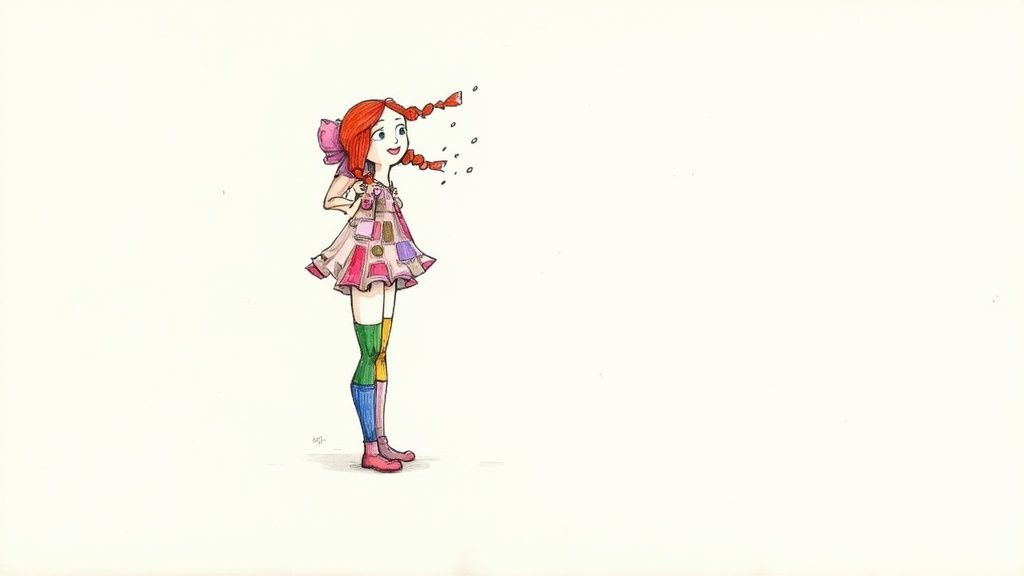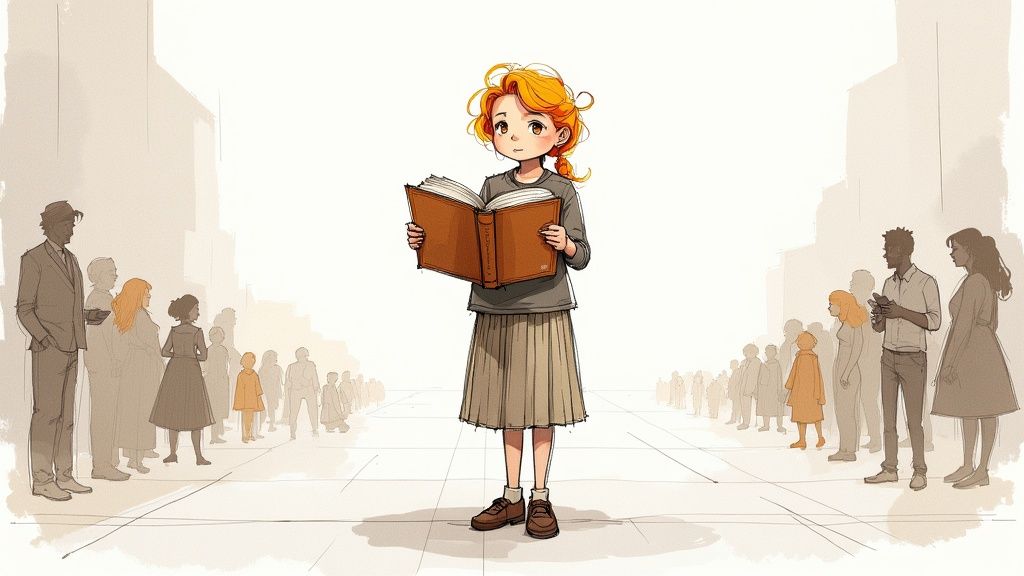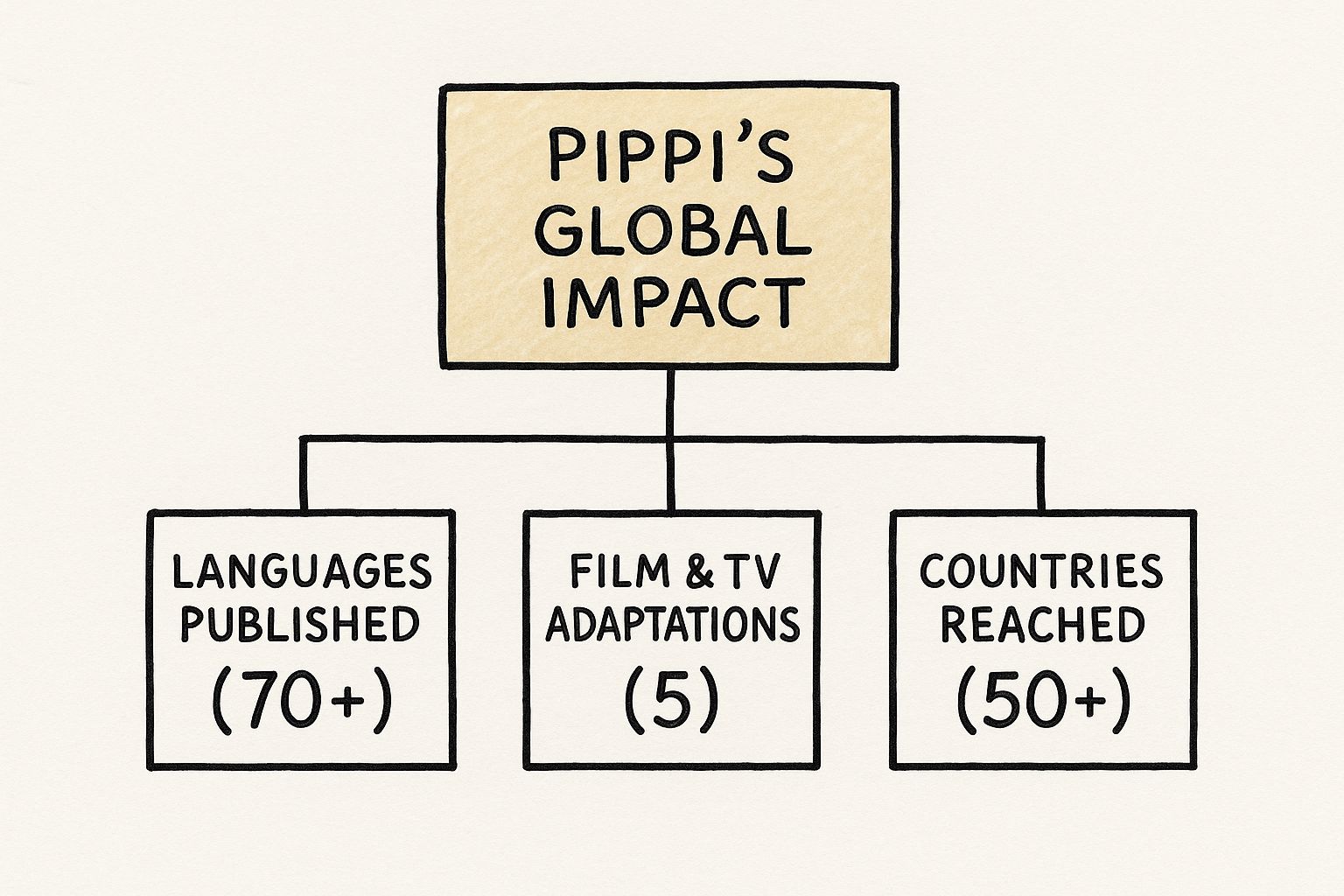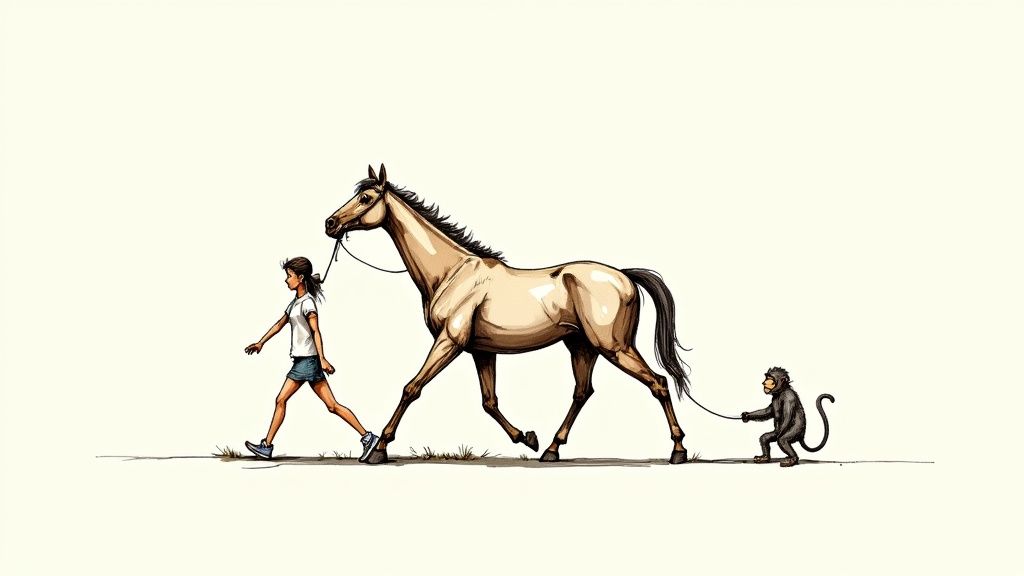Let me introduce you to Pippi Longstocking. She’s a nine-year-old girl with superhuman strength, a pet monkey, and a spirit of adventure that just can’t be tamed. Pippi is the star of the classic children's books by Swedish author Astrid Lindgren, instantly recognizable for her mismatched socks, fiery red pigtails, and a wonderfully playful disregard for adult rules.
The World's Strongest Girl

Can you picture a nine-year-old living all by herself, who’s strong enough to lift a horse with one hand? That's Pippi Longstocking. She doesn't just break the rules—she rewrites them entirely. She lives in a quirky, colorful house she calls Villa Villekulla, and her family is just as unconventional: a monkey named Mr. Nilsson and her horse, who happily lives on the porch.
Pippi's life is a whirlwind of fun, funded by a suitcase overflowing with gold coins and fueled by an endless supply of fantastical stories. She was a complete departure from the polite, obedient children you’d typically find in stories from her time. Pippi is fiercely independent, answering to no one and living life completely on her own terms.
A Character Ahead of Her Time
So, what makes Pippi such an unforgettable character? It’s more than just her incredible strength or her playful personality. When she first appeared in 1945, she embodied a spirit of freedom and self-reliance that was truly groundbreaking. She constantly challenges the stuffy expectations of her quiet town and questions the authority of every adult she meets.
Her character really comes down to a few key things:
- Unwavering Self-Confidence: Pippi is completely comfortable in her own skin. She never once doubts her own strength or her decisions.
- A Strong Moral Compass: For all her chaotic behavior, she has a deep-seated sense of fairness and is always the first to defend the underdog.
- Boundless Imagination: She can turn the most mundane situations into magical adventures, seeing the world not just as it is, but as it could be.
Pippi showed generations of readers that it's okay to be different, to be loud, and to live with courage. She is a true icon of empowerment, inspiring children everywhere to find their own strength.
Why She Still Resonates
Decades after she was created, Pippi remains a beloved character because she represents the ultimate childhood freedom. She’s a testament to the power of individuality and has become a symbol for strong female characters in literature.
Her legacy lives on, and you can see her influence in many modern collections of inspiring girl books. Pippi's adventures continue to capture hearts, proving that a little bit of rebellion and a lot of kindness can make the world a much more interesting place.
A Journey Through the Pippi Longstocking Books
To really get to know the girl with the gravity-defying braids, you have to follow the adventures Astrid Lindgren first dreamed up for her. The heart of the Pippi Longstocking saga is a classic trilogy, with each book building on the last to paint a full picture of this wonderfully strange hero. Her journey kicks off in a way that perfectly sets the tone for everything to come.
The first story, simply titled Pippi Longstocking, introduces us to Villa Villekulla and its new nine-year-old owner. When she moves in next door to the very proper Tommy and Annika Settergren, their neat and tidy world gets flipped on its head. Pippi doesn't waste a moment showing off her super-strength, her fierce independence, and her hilarious habit of questioning every single adult rule she comes across.
Pippi Goes on Board
In the second book, Pippi Goes on Board, the adventures get even wilder. This one is packed with some of her most famous escapades, from shopping sprees where she buys out entire stores to outsmarting clueless adults with nothing but pure confidence. Pippi's knack for storytelling hits a whole new level here, blurring the lines between what’s real and what’s make-believe in the most wonderful way.
But this book also hits a surprisingly emotional note. Pippi’s father, Captain Efraim Longstocking, shows up to whisk her away on his ship to become a princess. The farewell is heartbreaking for Tommy and Annika, and Pippi’s final decision to stay with her friends shows just how deep their bond is. It's a beautiful reminder that friendship is the greatest adventure of all.
This choice shows that beneath her wild exterior, Pippi Longstocking values connection and loyalty above all else. She actively chooses her found family over a life of royalty, a powerful statement about love and belonging.
Pippi in the South Seas
The last book in the original trilogy, Pippi in the South Seas, finally delivers on the promise of a grand sea voyage. This time, Tommy and Annika get to come along with Pippi and her father on a trip to Kurrekurredutt Island, where Captain Longstocking is king. The siblings get to see a world far beyond their quiet Swedish town, one filled with new customs, exciting challenges, and Pippi’s one-of-a-kind way of solving problems.
This adventure is the perfect finish to her story. It highlights her leadership, her kindness, and her incredible ability to bring joy and a bit of chaos wherever she goes. The trilogy beautifully tracks her growth from a mysterious new kid on the block to a loyal friend and a true leader.
There’s a reason the Pippi Longstocking books became a global phenomenon. Since the 1940s, these stories have been translated into about 70 languages, proving just how much they resonate with people everywhere. You can learn more about the worldwide reach of Astrid Lindgren's work on her official site.
To really connect with the wonderful stories and characters in the Pippi Longstocking books, parents might also find it helpful to look into tips to improve reading comprehension to help young readers fully soak up the magic in these timeless tales.
Unpacking the Enduring Themes of Pippi's World

The adventures of Pippi Longstocking are so much more than just quirky, fun-filled stories. Dig a little deeper, and you’ll find they’re built on powerful ideas that still hit home with readers today. Underneath all the chaos and fun is a profound celebration of radical self-reliance. Pippi not only survives without any adult supervision, she thrives, proving that a child can absolutely be the master of her own world.
Her very existence is a joyful middle finger to authority and the stuffy social rules of her day. When Pippi runs into a rule that makes no sense to her, she doesn’t just break it—she makes you wonder why it was ever a rule in the first place. This playful rebellion is right at the heart of her charm and a big reason we still love her.
The Power of Imagination
If there's one central theme in the Pippi stories, it's the incredible power of imagination. To Pippi, the world isn't some fixed, boring place run by adult logic. It’s a giant canvas for her creativity. The floor can be an ocean. A simple walk down the street can become a grand expedition.
She doesn't use her imagination to escape reality, but to shape it into something far more magical and exciting. It's a beautiful lesson in finding joy in the everyday. Pippi shows us that with a little creativity, anyone can turn the mundane into the magnificent.
Pippi embodies the idea that your mind is your greatest playground. Her ability to transform ordinary moments into extraordinary adventures is a testament to the limitless potential of a creative spirit.
A Symbol of Empowerment and Change
At her core, Pippi is a powerful symbol of empowerment. She's fiercely strong, completely financially independent, and makes zero apologies for who she is. This was a huge deal back when most female characters in children’s books were expected to be polite and passive. The importance of this kind of https://www.number6publishing.com/blogs/number-6-blog/representation-in-childrens-books can't be overstated, giving young readers a truly inspiring and different kind of role model.
Her influence even spilled over from the page into real-world culture. A 1969 Swedish TV drama famously portrayed Pippi as a bohemian, free-spirited figure, echoing the counter-cultural movements happening at the time. This interpretation fits perfectly with the view of her as “a hippie before the 1968 movement,” cementing her status as a true icon of unconventional thinking.
Pippi’s legacy really boils down to a few key themes:
- Self-Sufficiency: She proves that kids are far more capable and resourceful than they're often given credit for.
- Anti-Authoritarianism: Her gentle defiance of grumpy adults encourages a healthy habit of questioning arbitrary rules.
- Unbound Creativity: She shows that imagination is basically a superpower that can make every part of life richer and more meaningful.
Through her fierce independence and wild imagination, Pippi Longstocking became more than a character. She became a symbol for anyone who dares to live life completely on their own terms.
The Unforgettable Characters in Pippi's Circle
While Pippi Longstocking is a whirlwind of fun all on her own, her world truly comes alive through the cast of characters who orbit her. From loyal best friends to completely baffled adults, these relationships are what show us the real Pippi—her deep kindness, her wild spirit, and the way she shakes up the sleepy little town she calls home.
Much of the series’ charm and humor comes from the clash between Pippi’s unbelievable freedom and the very conventional lives of those around her.
Her Best Friends and Animal Sidekicks
At the very heart of Pippi's adventures are Tommy and Annika Settergren, the perfectly behaved brother and sister who live right next door. Before Pippi moved in, their lives were neat, predictable, and frankly, a little bit boring. Annika is sweet and a bit cautious, while Tommy is more adventurous but still very much a product of his proper upbringing. They are the perfect audience for Pippi’s tall tales and eager partners in her chaotic plans.
Their friendship shows us that Pippi isn't just a rebel; she's a fiercely loyal friend who brings a much-needed dose of joy and excitement into their orderly world.
Pippi’s unconventional family wouldn't be complete without her animal companions, who are just as much a part of Villa Villekulla as she is.
There's her tiny monkey, Mr. Nilsson, who is her constant sidekick. You'll often see him dressed in adorable little outfits, tagging along on every adventure and adding another layer of delightful absurdity to the scene.
And of course, there's her spotted horse, whom she can lift with one arm. Forget a stable—he lives right on the porch of Villa Villekulla. These two aren't just pets; they are her family, treated with the same love and respect Pippi shows all her friends.
The Baffled Adults of the Town
Pippi’s unshakable logic and confidence are constantly at odds with the rigid adults trying to make her follow their rules. This leads to some hilarious moments, especially with the bumbling police officers, Kling and Klang. Their attempts to take Pippi to a children's home are always met with playful games and incredible feats of strength that leave them scratching their heads in disbelief.
Then there’s Mrs. Prysselius, a well-meaning but very stern social worker who is determined to give Pippi a "proper" upbringing. She is the voice of society's expectations, which makes her the perfect foil for Pippi’s free-spirited independence. These run-ins are more than just funny; they get to the heart of the story's message about questioning authority and celebrating what makes you unique.
Here's a quick look at the main characters you'll meet in Pippi's world and the roles they play.
Pippi Longstocking's Inner Circle
| Character | Role in the Story | Key Personality Traits |
|---|---|---|
| Tommy & Annika Settergren | Pippi's best friends and neighbors | Well-behaved, curious, loyal, and swept up in Pippi's adventures. |
| Mr. Nilsson | Pippi's pet monkey and sidekick | Mischievous, loyal, and often dressed in charming little outfits. |
| The Horse | Pippi's spotted horse | Strong, lives on the porch, and serves as Pippi's unconventional steed. |
| Kling & Klang | Local police officers | Bumbling, easily confused, and represent the ineffective side of authority. |
| Mrs. Prysselius | The town's social worker | Stern, well-meaning, and constantly trying to "civilize" Pippi. |
These characters create the perfect backdrop for Pippi's escapades, each one highlighting a different facet of her incredible personality.
The infographic below shows just how far Pippi's influence has spread beyond her tiny Swedish town.

This really brings home the global reach of her story, connecting with kids and families in dozens of countries and languages. To keep the fun going, you can let your own kids engage with their favorite characters by exploring fun cartoon character coloring sheets.
Pippi Longstocking's Legacy on Screen

Pippi Longstocking's wild spirit and chaotic energy were practically made for the screen. It was a natural next step that allowed her story to burst out of the books and find a home with audiences all over the world. Her on-screen journey kicked off in Sweden but quickly went global, cementing her image in pop culture for generations of kids to come.
Without a doubt, the most iconic version is the 1969 Swedish television series starring the unforgettable Inger Nilsson. For millions, Nilsson simply was Pippi. She perfectly captured that mischievous grin, the fiery red braids, and the unshakeable self-confidence. The series was later recut into feature films, and it’s this version that locked in the visual identity of Pippi Longstocking that so many of us still picture today.
Different Takes on a Classic Character
Over the years, Pippi’s world has been re-imagined by different creators, each bringing their own unique flavor to her adventures. While the Swedish series is often held up as the most faithful, other adaptations introduced her to completely new cultural settings.
- The New Adventures of Pippi Longstocking (1988): This American musical brought Pippi stateside with a big-budget Hollywood feel. It kept her joyful chaos intact but added a whole lot of song-and-dance to her escapades.
- Pippi Longstocking (1997): A Canadian animated series was the first introduction to Pippi for a whole new generation of kids. This version really leaned into the whimsical, almost magical parts of her stories, making it a perfect fit for Saturday morning cartoons.
Each adaptation shines a light on a different facet of her personality, from her anti-authority streak to her limitless imagination, proving just how universally appealing she really is.
No matter the format, the core of Pippi remains the same: a celebration of independence, strength, and the courage to live life on your own terms. The screen adaptations ensured her legacy would not be confined to the page.
An Enduring Global Influence
The success of these adaptations was a huge part of what turned Pippi Longstocking into a global phenomenon. By 2010, Astrid Lindgren's books had sold an incredible 167 million copies worldwide, and Pippi’s stories were a massive part of that number. Seeing her on screen amplified her reach, helping sell millions of books in English-speaking countries alone. You can discover more about Astrid Lindgren's incredible impact on world literature.
From live-action films to animated shows, Pippi's on-screen legacy is a testament to her timeless charm. These adaptations have kept her story alive and kicking, making sure the world's strongest girl continues to inspire and entertain children everywhere. It just goes to show that a good story knows no boundaries.
Answering Your Questions About Pippi Longstocking
Even decades after she first burst onto the page, Pippi Longstocking is one of those characters who just makes you wonder. Her totally unconventional life and wild spirit get readers of all ages asking questions.
So, let's dig into some of the most common ones. From her fantastically long name to the real-world story behind her creation, these details just make the world's strongest girl even more fascinating.
How Did Pippi Longstocking Come to Be?
The story behind Pippi Longstocking is a wonderful mix of a child’s imagination and a mother’s love. It all started in the winter of 1941, when author Astrid Lindgren’s daughter, Karin, was stuck in bed with pneumonia. To help pass the long hours, she asked her mom to tell her a story about a character she made up on the spot: Pippi Longstocking.
Lindgren started spinning these wild, wonderful tales right then and there. They became a regular routine, but they were just spoken stories. A few years later, after Lindgren sprained her ankle and was laid up herself, she finally wrote them all down as a tenth birthday present for Karin. After one publisher turned it down, a revised version was published in 1945, and a literary legend was born.
What Is Pippi Longstocking's Full Name?
Pippi's name is just as over-the-top and memorable as she is. When she recites it, usually to some baffled adult, it’s quite a mouthful: Pippilotta Delicatessa Windowshade Mackrelmint Efraim's Daughter Longstocking.
It’s the perfect name for her, really. It’s playful, absurd, and couldn't care less about convention—just like Pippi herself. That name is the first clue that you’re not dealing with an ordinary kid, setting the stage for all the larger-than-life adventures to come.
Why Was Pippi Considered So Controversial?
When Pippi first showed up in the 1940s, she was a complete shock to the world of children's literature. She was seen as controversial simply because she broke every rule for how a child, and especially a girl, was expected to behave.
Think about it: she lived happily all by herself, had superhuman strength, openly mocked school, and challenged every authority figure she came across.
Some early critics were genuinely worried that Pippi was a terrible role model. They thought she would teach kids to be disrespectful and disobedient, and that her anti-authority attitude would inspire pure chaos.
But for every critic, there were far more readers who saw her for what she was: a powerful symbol of freedom, childhood empowerment, and thinking outside the box. That’s the legacy that has stuck, making her a celebrated female main character book icon for generations. Pippi's rebellion was never mean-spirited; it was just a joyful, pure expression of her own independent spirit.
Where Can I Find the Pippi Longstocking Books?
Good news! The Pippi Longstocking books are timeless classics, and they're incredibly easy to find today. They’ve been translated into more than 70 languages and are still in print all over the world.
- Local Libraries: A fantastic, free way to borrow the books individually or as a complete collection.
- Bookstores: Whether you have a big chain or a small independent shop nearby, you can bet they have Pippi on their shelves.
- Online Retailers: Sites like Amazon, Barnes & Noble, and Bookshop.org carry paperbacks, hardcovers, and boxed sets.
- Digital and Audio Formats: You can easily find e-books for your tablet or listen to audiobook versions on platforms like Audible—perfect for family road trips.
No matter how you like to read, Pippi’s adventures are right there, waiting for a new generation to discover them.
At Number 6 Publishing, we believe in the power of stories that spark imagination and encourage individuality, just like Pippi's. If you're looking for more unforgettable books for young readers, explore our curated collections at https://www.number6publishing.com.
